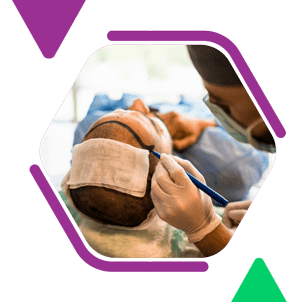- Home
- About Us
- Hair Treatment
- Hair Transplant
- Hair Loss
- Causes of Hair Loss
- Clinical Features
- Laboratory Test
- Medical Treatment
- Cyclic Treatment
- PRP
- Laser Treatment
- Surgical Treatment
- FUE
- Robotic
- FUT
- Beard Reconstruction
- Moustache Reconstruction
- Eyebrow Reconstruction
- Side Burn Reconstruction
- Complications Of Hair Transplant
- Alopecia Areata
- Telogen Effluvium
- Cosmetic Surgery
- Plastic Surgery
- Gallery
- Blogs
- Contact Us
Medical Treatment

Medical Treatment
Management of androgenic alopecia in males.
Cyclic Treatment
- Protiens
- Calcium
- Iron
- Multivitamins
- Brahmi
- Finasteroids
- Minoxidil solution 2% for local application
- Ketaconazole shampoo for dandruff
- Routine shampoo for daily hair wash and conditioning
FDA approved Finasteroids for the treatment of AGA in 1997.
Finasteroids is most common treatment approach for male AGA.
It is synthetic 4-azasteriod compound that is specific inhibitor of type II 5µ-reductase inhibitor and responsible to reduced serum and tissue level of DHT.
Finasteroids does not have any hormonal properties in itself and has no estrogenic, antiestrogenic, or progestational effects.
A daily dose of 1 mg is the optimum dose for treatment of AGA. It can be taken with or without food.
Finasteroids is well tolerated, and side effects occur in less than 2% of patients.
Side effects include
- Decreased libido (1.8%)
- Erectile dysfunction (0.8%)
- Decreases ejaculate volume (0.4%)
Side effects subside spontaneously in those who want to continue treatment in 59% and are reversible upon cessation of treatment.
The effect on prostate size and serum prostate-specific antigen (PSA) in this young population without BPH was small and reversible upon discontinuation.
There is no evidences of a casual link between finasteride and persistent sexual dysfunction.
Minoxidil:
Minoxidil is piperidinopyrimidine derivative originally used as an oral antihypertensive as a smooth muscle vasodilator.
Mechanism of Action:
It have mitogenic , nonhormonal effects on epidermal cells leading to prolonged survival time as well the capacity to induce increased proliferation on hair follicles in vitro.
A change in intracellular calcium homeostasis has been suggested because minoxidil is converted to minoxidil sulfate, a potassium channel antagonist that increases potassium channel permeability, leading to the entry of calcium into the cell. This active metabolite is believed to be responsible for hair growth stimulation.
The sulfotransferase enzyme (SULT1A1) activity in the hair follicle correlates with minoxidil response.
Minoxidil 5% solution or foam twice daily is approved for the treatment of AGA in men.
Side Effects
- Contact dermatitis
- Transient shedding during first two months of use.
Dutasteride:
Mechanism of action:
Dutasteride is dual inhibitor of both types I and II 5µ-reductase that inhibits the conversion of testosterone to DHT. It is not approved by the FDA for treatment of AGA. Only in Korea has dutasteride at a dose of 0.5 mg daily been approved for treatment of AGA.
Side Effects
- Breast enlargement and tenderness.
- Reduced sperm count.
- Decreases libido
- Erectile dysfunction.
- Decreased ejaculate volume.
Prostaglandin Analogs
The prostaglandin F2a analogs Latanoprost and Bimatoprost are used in treating ocular hypertension and glaucoma.
A noted side effect is increased eyelash hair growth ,a feature that has been investigated in several stdies. Bimaprost is now available as a treatment for eyelash growth.
Latanoprost can be used for treatment of AGA.
Ketoconazole
- Ketoconazole is an imidazole antifungal agent: it is effective for the treatment of dermatitis and dandruff.
- Its action on scalp microflora may benefit those with AGA- associated follicular inflammation.
- Ketoconazole is also an antiandrogen and has been suggested to improve hair growth in AGA through androgen-dependent pathways.
- Ketoconazole shampoo 2% on MPHL showed increased hair density in addition to increased size and proportion of anagen follicles compared to those using non-medicated shampoo.
- Ketoconazole shampoo is used in conjunction with other AGA treatments.
ACell MartiStem
- ACell MatriStem is an extracellular matrix derived from porcein urinary bladder.
- It contains anetwork of collagens and proteins.
- It contains growth factors and is known to recruit progenitor cells.
It may help in tissue regeneration and follicle regeneration.
Cell Therapy and Cloning:
Still under the experimental stage.
Our Services
- Hair Loss
- Causes of Hair Loss
- Clinical Features
- Laboratory Test
- Medical Treatment
- Cyclic Treatment
- PRP
- Hair Transplant
- Surgical Treatment
- FUE
- FUT
- Beard Reconstruction
- Moustache Reconstruction
- Eyebrow Reconstruction
- Side Burn Reconstruction
- Complications of Hair Transplant
- Alopecia Areata
- Telogen Effluvium
- Laser Treatment



 Book an Appointment
Book an Appointment